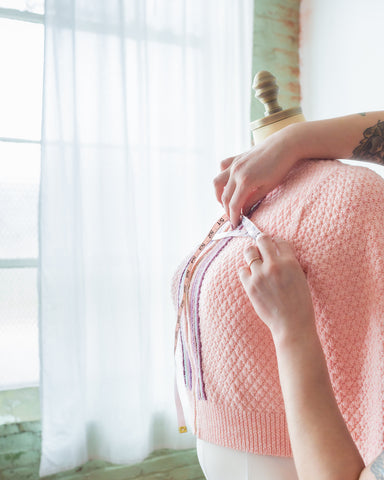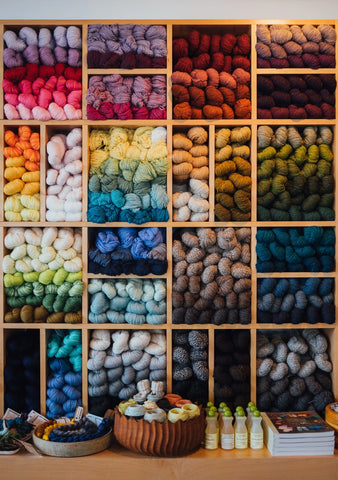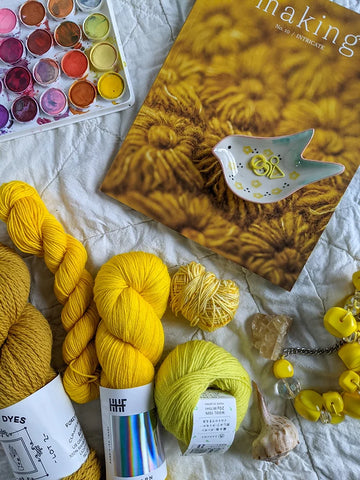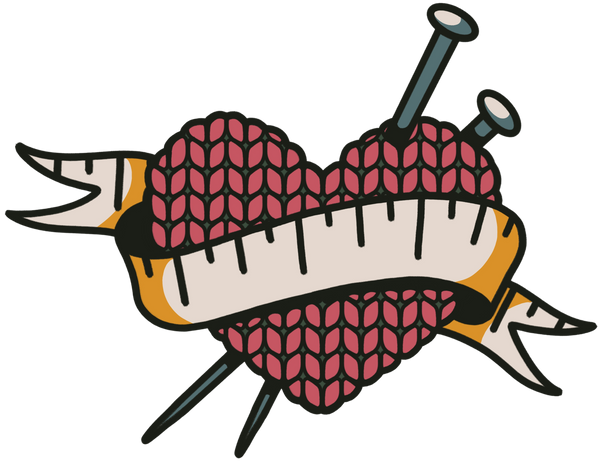
45 actions on size inclusion
We, the knitters
Knitters take a tremendous amount of personal responsibility for changing the world. They want to buy carefully, share thoughtfully, and use their dollars, voices, time, and other resources to create a more just world.
And.
We can’t do it alone.
Let’s back up a bit. What’s size inclusion?
Size inclusion in the knitting world is offering products that meet the needs of bodies of all sizes, not just the smallest (or in some cases the medium-est).
Yes. There are other justice movements.
This list is excerpted from an email that went out in my newsletter in May, 2022, a week when the US is facing threats to reproductive justice and has been rocked by a white supremacist terrorist attack and an attack targeting Taiwanese Americans. In our own knitting world, an online publication published hate speech directed at valuable members of our community.
Does size inclusion pale in comparison to the need for sweeping social justice work to address racism? Absolutely. Is it either/or? No.
I’m of the opinion that those of us who have a calling to do any kind of justice work have a responsibility to do that work to the best of our ability, while supporting, empowering, and incorporating the teaching of activists doing other justice work. I acknowledge it’s weird to be talking about bust sizes while the world is on fire, but here we are.
More power = more responsibility
So yes, knitters can change the world by voting with their dollars. AND brands and companies in the industry have the responsibility to use their resources, authority, and social capital to effect change. So what role can each of us play as we try to envision a more inclusive future?
Note - no one is perfect. There are things on this list I'm trying to do more of, be better at, or bring more into the center of my work. We are all works in progress. And as always, I TOTALLY WELCOME your feedback, so if you disagree with me, have more to add, or want to know more, join me in the comments!
The following list is organized by the activities we DO. You might find you fall into more than one category! Don't work in the industry? Some of these tips might be things you'd like to advocate for when you're speaking to the brands you shop with.
45 Actions to Take on Size Inclusion

If you buy patterns
1. Purchase patterns from designers who grade their patterns TO FIT a bust at least 60”. Each size should be graded with consistent ease.
2. Buy patterns that are shown on a variety of bodies.
3. Excited about a pattern and want to share it? Share the one knit by a fat person! Be conscious of the ratio of straight-sized to plus-sized bodies you share on social media. Is it equal? Should it be? Maybe there should be more fat bodies everywhere?
4. Interrogate your expectations of price. Patterns used to come in 5 tightly clustered sizes and cost $5-9. Now, patterns come in 9-12 sizes and require additional skill, time, and expertise - as well as additional editing costs and beta knitting support.
If you have a physical presence in a shop or at shows
5. If you have seating, is it size-inclusive? How much weight do your seats support, and do they have arms?
6. Position coffee tables far enough from seating to be comfortable for all knitters.
7. Consider aisle size, can everyone easily navigate your space?

If you sell yarn
8. Stock enough yarn in each colorway that a fat person can buy sweater quantities as easily and quickly as a small-bodied person. If a size B doesn't have to ask for a special order, a size J shouldn't either.
9. Display samples in a range of sizes, whether online or in person.
If you provide yarn support
10. Have a frank conversation with the designer about your values.
11. Be sure that the designer has adequate skills or support for size-inclusive grading.
12. If you offer kits, offer the same shopping experience for all sizes.
If you’re a publisher

13. Design compensation structures that reflect the expertise, skill and experience required to create a size-inclusive pattern.
14. Provided designers a thoughtful, well-researched size chart rather than having designers bring their own (thanks for this tip, Julie!).
15. Have technical editors review schematics before the designer grades the pattern to ensure a consistent grade in relation to the size chart and stated ease.
16. Allow enough time for designers to create thoughtful grading for all sizes.
17. Expand the number of pages permitted for patterns. Give adequate pages in the publication for the shaping required to meet the needs of ALL body sizes.
18. Hire tech editors that are skilled graders and well educated on fit topics.
19. Host a beta-knitting program (more on this below).
20. Create a dialogue with designers. Designers unfamiliar with the process of working with publications may be terrified you’ll think poorly of them if they ask questions.
If you’re showing a sweater or accessory on a mannequin or modeled (in a shop, at a show, in a pattern or magazine)
21. Provide the measurements of the body or mannequin - full bust, upper chest, upper arm.
22. State clearly whether the garment has or has not been clipped or otherwise manipulated for photography.
23. Display patterns on a variety of body sizes. Represent the top of the size range. Do not use mannequins that are smaller than the US average (around a 44" bust)
If you’re designing or writing patterns
24. If you’re not confident grading in all sizes, invest in support. Even if your pattern is free. Don’t create things that cause emotional pain for knitters.
25. Grade your schematic BEFORE you knit your sample. This will prevent ungradeable design features and will help you think about how each feature will play out for each size before you lock anything in. (Read Joji Locatelli’s post on a design she had to scrap)
26. Consider booking time with a consultant or tech editor after you grade the schematic but before you start pattern writing. It can save you lots of time and give you new ideas. Also, it’s much easier mentally to start from scratch if you haven't already invested weeks in grading and writing.
27. Can a seamless, in-the-round design in a slippery fiber be size-inclusive if the larger sizes will lose their shape after wearing? Evaluate fiber properties and the consequences of construction. You may need to incorporate more structure and/or use two gauges (one at the top and one at the bottom, to account for the extra weight).
28. Add multiple sizes for wraps and shawls or provide instructions on how to make them larger (including yardage).
29. Offer sizing recommendations based on something other than (or at least in addition to) full bust. The whole sweater must fit, not just the widest part of the bust. Provide tips on sizing up or down.
30. Make modifications easier for knitters. Provide yardage on how to increase length, include bust sizing, and/or multiple sleeve sizes. Insert sidebars on how to modify or link to resources that will help knitters draft them on their own. (thanks for sharing your thoughts on this, Cassandra!)
31. Keep your size chart consistent over time so knitters know how your patterns will fit them. Make changes to your size chart slowly and thoughtfully.
If you host test or beta knit programs
32. Run long programs. Plan at least 1 week for every 200 yards used in the largest size, plus additional time if there’s complexity or difficulty. Consider a minimum of 12 weeks for long-sleeve sweaters.
33. Schedule knitters a few weeks before the program starts. This gives knitters who are already committed to finishing large projects time to wrap up.
34. Share the full schematic in your testing call. Encourage testers to modify their sweaters for fit. Here's how I do it.
35. Price accessibility IS size inclusion: share finished objects made in yarn at all price points.
36. Share photos of your testers. Especially the ones in larger bodies. Share information on any modifications they made.

If you’re selling patterns
37. Offer the entire schematic before purchase, with all measurements.
38. Don’t recommend a range of ease unless there’s a very good reason. Use the number you graded with.
39. Provide yardage, not just the number of skeins.
If you're an editor
Many thanks to Kristina McGrath for contributing the following (edited to condense!):
40. Work with designers and companies who are committed to creating size-inclusive patterns. Offer to help expand their size range, but stick with your values.
41. Check the grade as part of your tech edit. Make sure the pattern works for all sizes and that the fit is good and is what is intended. You can read more about that here.
42. Educate yourself about fit and bodies, pattern elements, and pattern writing. Be familiar with extensive sizing standards and common fit issues that happen at each section of the size range. Watch out for these things as you edit. Learn what it means to grade for multiple sizes, learn about ease and how it works and why it matters.
43. Find resources that can help your clients. Be helpful and answer client questions about fit and sizing, but if you don't know the answer say so. Keep a list as you find things that can help.
44. Share what you know. On social media, in emails, wherever you are online, and in person if applicable. Spreading the word about what works and what doesn't in grading inclusively will eventually make a difference. Spreading the word that people of all sizes deserve clothes that fit will hopefully help someday too. Fuck fatphobia.
If you’re anyone
45. Constantly be learning. Learn from knitters in larger bodies. Learn about the mechanics of fit. Learn about different techniques for addressing fit issues. Learn about different ideas. Challenge ‘why it’s done this way.’
As you've worked through this, you may be thinking 'this is also a good practice for another issue I care about!" I agree. The above all flows from my framework for racial and social justice, and you can learn more about that on my blog (link to be updated).
Let's work together

If you're a designer and you'd like to develop your size-inclusion toolbox, let's talk!
I work with designers on grading & design consulting on an hourly basis, and I most typically work with designers who want to build out their skills and become more confident over time.
A typical engagement would be meeting at the beginning of your project and discussing your planned schematic, any areas you anticipate being tricky, and going over the ways you might address them. As you get into the grading, I'm available to help by answering questions or reviewing the decisions you've made.
I also offer full-service grading, or we can do an arrangement where I'll grade your pattern and then walk you through exactly what I did. Then on your next pattern, I can be a little less involved, until you're flying on your own.
Finally, I frequently work with designers to imagine how their tests, marketing plans and other aspects of their business can be transformed to better serve knitters in larger bodies, among other topics.
To get started, book a free 15 minute coffee meeting with me, to see if something you've been pondering might be a good match for design consulting! You can learn more about my services for designers here.
